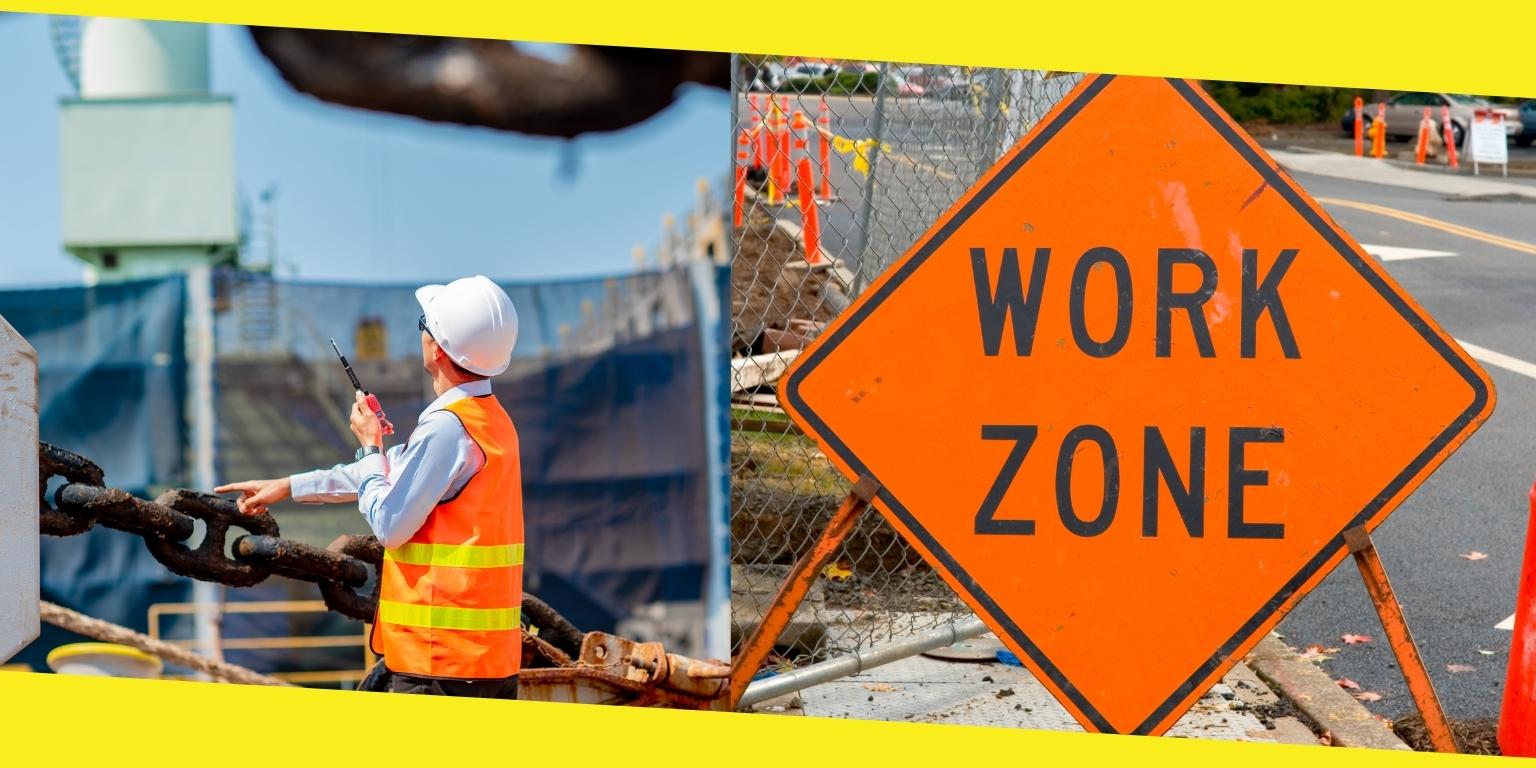How Do You Create a Safe Work Zone?
This post was last updated on March 23rd, 2024

Safety is more than putting up or erecting a work zone sign. It is much more.
And just how do you create a safe work zone? Please read on.
Contents
ToggleDevelop a Traffic Control Plan
Anything worth doing requires understanding and planning. Creating a safe work zone is no different. In this vein, the ANSI/ASSP A10.47 standard, Work Zone Safety for Highway Construction that establishes requirements for the construction and maintenance of highways and roads to establish safe work practices and prevent injuries and fatalities requires, among others, that you develop a traffic control plan.
However, in our view, before developing a traffic control plan that will create a smart work zone, an understanding of your work zone is key. No matter the size of the roadway, an understanding of the regular traffic flow on a specific roadway and how construction activities will disrupt its flow should always be your priority.
Only after you have a firm understanding of this, do we advise that you use it to develop a traffic control plan to control traffic throughout a construction project and protect your workers and motorists. According to the ANSI/ASSP A10.47 standard, once such information is in hand, the project constructor should establish a traffic control plan for the entire work zone that addresses four key areas:
- The advance warning area: The section of the highway where road users are informed by a work zone sign about the upcoming work zone or incident area.
- The transition area: In this section, road users are directed by a work zone sign out of their normal route.
- The activity area: The area where work activity occurs. It is made up of the workspace, the traffic space, and the buffer space-all as indicated by work zone signs.
- The termination area: The area in which users, by a work zone sign, return to their normal route.
Once you have developed a traffic work plan, the next step is implementation.
Implement Protective Safety Measures
Developing a traffic control plan is just the beginning. Actually, putting it in place to create that more than vital protective barrier between motorists and your workers is an essential step. Founded on your established traffic control plan, as decision-makers you must implement the determined plan as to the barriers and work zone signs most suitable for the protection of motorists and your workers. It is only when this is done that motorists will be able to traverse the roadway as guided by the work zone signs you will have put in place, and your workers can perform their tasks safely.
In line with the above, A10.47 declares that you should consider positive protection measures for each of the following:
- Working zones such as tunnels and bridges, which provide no means of escape from external motorized traffic encroaching onto or interfering with the workspace (hopefully not because of the absence of work zone signs.)
- Long duration work zones of two weeks or more that lead to employees being substantially exposed to motorized traffic.
- Projects with high traffic volumes of more than 20,000 vehicles per day, traveling at anticipated operating speeds of at least 45 mph or 72 km/h, especially when combined with work operations that place employees within one-lane-width of travel lanes open to traffic.
- Drop-offs or unfinished bridge decks and roadside hazards that will remain in place overnight or longer.
Protective work zone signs and related measures come in many forms. For example, electronic signage, arrow panels, rumble strips, and pavement markings. One or a combination of these methods may help improve safety, depending on the project. As a safety professional working with these hazards and exposures, you should determine the most appropriate controls for a particular project based on site-specific circumstances. This brings us to the next point. Always be seeking ways to improve your workers’ visibility. Such as with our protective work zone signs perhaps?
Improve Worker Visibility
You will undoubtedly agree with us that for motorists to drive safely around workers on a roadway that’s under construction or maintenance, they must first be made aware of said workers’ presence. In light of this, A10.47 unequivocally declares that:
All workers, including emergency responders, right-of-way who are exposed either to traffic (i.e. vehicles using the highway for purposes of travel) or to work vehicles and construction equipment within the work zone, must wear high-visibility safety apparel that meets the Performance Class 2 or 3 performance requirements of ANSI/ISEA 207.
To us, such apparel becomes extremely important during night-time construction situations when overall visibility is diminished.
In addition, A10.47 also highlights illumination requirements to develop an illumination plan for night work. A plan of that nature is essential if your workers are to be clearly visible and to help control glare as they work under night-time conditions.
Alongside work zone signs and Personal Protective Equipment (PPE), flaggers frequently play the most important role in making motorists aware of the presence of workers. Then, via the use of hand signals, signs, or automated devices, they also control traffic flow.
Given flaggers’ vital contribution, the A10.47 provides guidance on how to best employ and position them as well as how to ensure they are visible and have an escape route should a traffic intrusion occur. This brings us to our fourth point-always use intrusion alert technologies.
Use Intrusion Alert Technologies
Whilst the first three steps can also help prevent workplace intrusions, workers need and must have enough time to react and get to safety when intrusions occur. This is where work zone intrusion alert technology (WZIAT) such as ours comes in handy.
There are different WZIAT technologies to alert workers of a work zone intrusion. Below are just a few that are available for your consideration.
- Intellicone
Other than that, it has the design of the traditional Intellicone safety cone, the one we have available is quite different. It includes a wireless audio-visual alarm system with audible tones of different pitches and oscillating cues. Add to this a portable site alarm and strobe lamps that are fitted onto safety cones and can communicate with one another. Even when your workers are 65 feet away from the work zone intrusion site, it will notify them.
- Intellistrobe
The Intellistrobe offers both audio and visual alerts for work zone intrusions. The audio alert is triggered when a vehicle pressurizes the hose. Its technology includes audio alerts, gate arm signal lights, and a pneumatic hose. Your operator can control the unit from a safe distance.
- SonoBlaster
A Sonoblaster is a carbon dioxide-powered alert technology. It is activated when the traffic cone supporting the unit is tilted. Two advantages of this device are that it can be attached to different types of barriers, such as cones, barrels, drums, security fences, barricades, and delineators. Secondly, it can determine the direction of an intruding vehicle.
- Traffic Guard Worker Alert System
The Traffic Guard Worker Alert System is a pneumatic, trigger-based alarm system. It comprises a lightweight visual-audio alarm unit, an audio-vibratory personal safety device, and a portable activation hose. The pneumatic tube is placed along with the cones and audio. When a vehicle compresses the tube, the system transmits intrusion information via microwaves that trigger flashing lights and alerts.
While we currently have the above-mentioned WZIAT in our arsenal, researchers Chukwuma Nnaji, John Gambatese, and Hyun Woo Lee have, however, encouraged the manufacturers of these devices to in future ensure they produce sounds greater than 93 dB within 50 feet in addition to limiting false alarms.
It is in the spirit of authoritative research and consultancy, that when creating a safe work zone for your organization, we advise that you always consult and have your work zone signs ready.
Most Inside
Most Inside offers high-quality recommendations and valuable updates to enhance all aspects of your life, providing premium guidance and enriching experiences.




